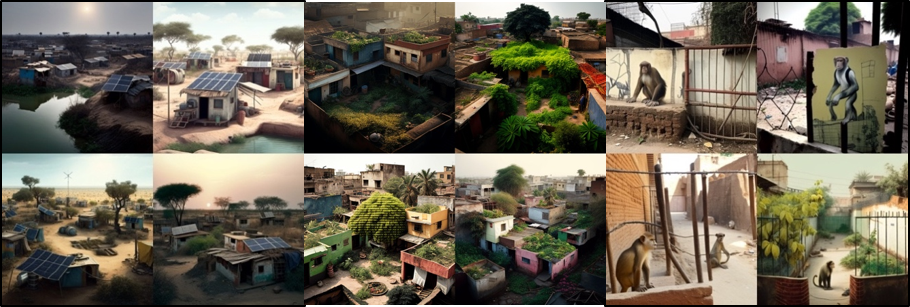AI for Climate Action

“The Earth is our only home, and we have a responsibility to protect it.”
This was the most convincing statement for people to support climate change polices. And it was authored by AI.
Artificial Intelligence (AI) is weaved into almost everything we do today, whether we realise it or not. In our banking apps AI can automatically tell us when to save or spend, on shopping websites it recommends new products to purchase, on streaming platforms it tells us what shows we should watch next. In the last year, we’ve seen a surge in publicly available models like OpenAI’s release of its Large Language Models (LLMs) GPT2/3/4 and ChatGPT which have encouraged many to use the models for a range of applications.
The climate crisis is accelerating. Each year we see rising temperatures, biodiversity loss, and parts of the world either engulfed in fire, submerged in floodwater, or in a drought with severe consequences for livelihoods and human lives itself. Despite this, many people are still reluctant to accept that we have to embrace lifestyles and policies that are compatible with limiting the global warming to 1.5°C. Much of this is due to how the climate crisis is framed in the public, the moral implications of our inactions are usually not spelled out explicitly and specifically. Most people would agree it’s wrong to harm others and would like to leave the world in a better place than they found it. We found this holds for climate policies too. As a species, it’s natural for us to care for those around us, so why not harness this in our climate communication?
One simple way of achieving this is through direct messaging to the public, with each message conveying a particular moral argument. Better still, could we not harness AI for this, with its access to the collective intelligence of humanity, with its ability to learn from thousands of arguments made for climate action around the world? We found GPT-3-generated messages to be much more effective than our own at convincing people to support climate policies, particularly if the messages are framed to convey morals of compassion or fairness. Suddenly you have an effective and scalable tool to promote climate-positive action in a way that resonates with people.
AI can also be used to help people visualise their climate-positive future. In a trial in the context of the LEED2023 For the Public Good initiative that paired up University of Leeds academics with artists and community leaders from the Global South, we did exactly that. Specifically, in collaboration with Kanchan Joneja (Co-Founder and Creative Head of Off Centre Collective, Delhi, India) and Lakshay Talwar (Co-Founder of the AeSha Foundation, Delhi, India), image-generating AI was used in a live workshop session with a marginalised community from Sanjay Colony, Bhatti Mines in Delhi, India. The AI generated post-carbon future visions based on hopes and visions that these people have for their communities. These communities are usually excluded from discussions about how we imagine our liveable futures, and AI can be an empowering tool for them to communicate their concerns, solutions, and visions more vividly and more appealingly. Read more about this project.
 The images above were generated by AI based on prompts from community members from the Sanjay Colony, Bhatti Mines in Delhi, India. On the left four images represent the usages of solar power, the middle four images represent greening of our cities, with roof-top gardens etc. and on the right four images represents AI’s failed attempts to find “solutions” to protecting roof-top gardens against monkeys
The images above were generated by AI based on prompts from community members from the Sanjay Colony, Bhatti Mines in Delhi, India. On the left four images represent the usages of solar power, the middle four images represent greening of our cities, with roof-top gardens etc. and on the right four images represents AI’s failed attempts to find “solutions” to protecting roof-top gardens against monkeys
Of course, AI isn’t without its pitfalls. Open AI (image- or text-generating AI) is heavily reliant on the prompts it is given, we found it was not great at coming up with new and imaginative ways to express ideas, and it is biased towards the data it has been trained on. For instance, in the trial with the community, we found the AI was overwhelmed with requests from the community to come up with a solution to protect roof-top gardens from ravaging monkeys (see images above).
But the real issue is our time is running out. For decades, fossil fuel companies have used targeted marketing to persuade the public that the continued use of traditional energy sources causes no harm and is necessary for development and raising people out of poverty. It’s time we call out these false promises and bring people together to envision positive post-carbon futures based on compassion and fairness. We should not shy away from using cutting-edge tools, such as AI, to persuade people to become Earth’s stewards and to empower them to come together and envision a positive future for themselves, their children and their grandchildren that is compatible with planetary boundaries.
This research was funded by UKRI Future Leaders Fellowship awarded to Dr Viktoria Spaiser, and an Alan Turing Institute Postdoctoral Enrichment Award awarded to Dr Nicole Nisbett. This blog post was written by Dr Nicole Nisbett.
